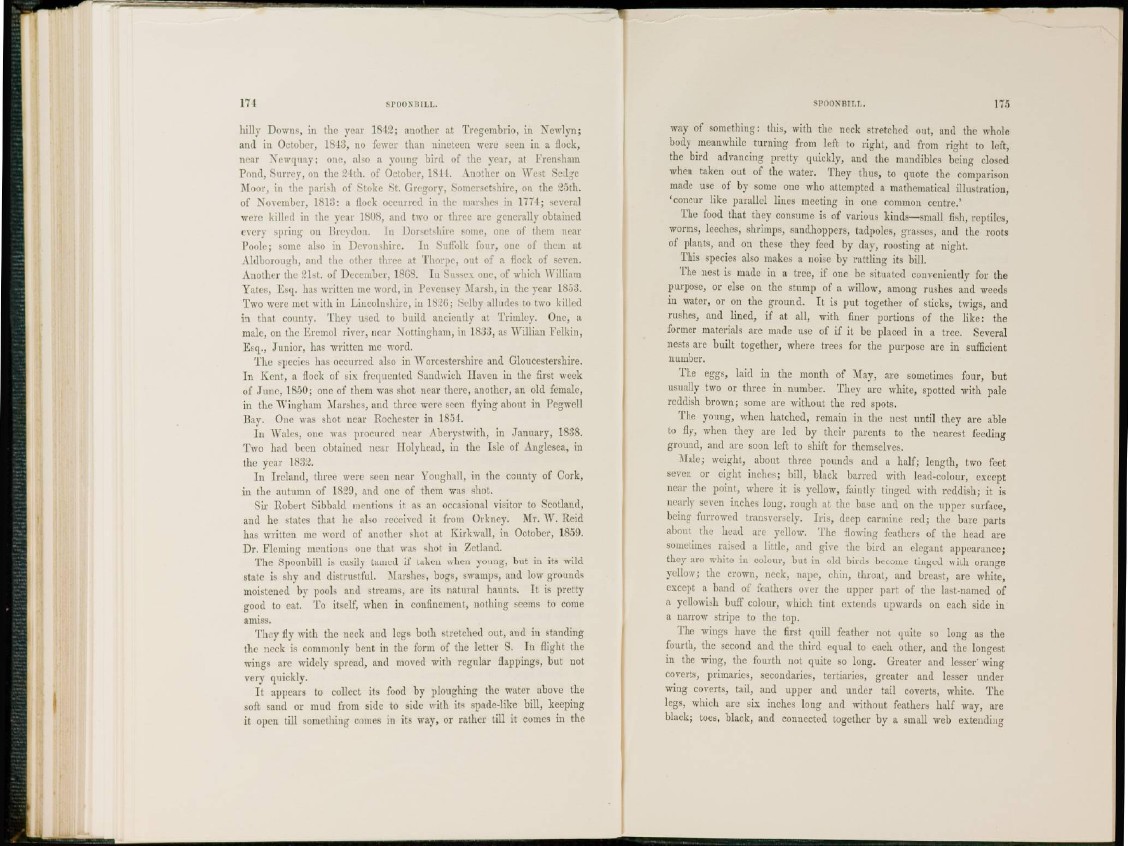
171 SPOONBILL.
hilly Downs, in the year 1842; another at. Tregembrio, in Newlyn;
and in October, 1843, no fewer than nineteen were seen in a flock,
near Newquay; one, also a young bird of the year, at Frensham
Pond, Surrey, on the 24th. of October, 1844. Another on West Sedge
Moor, in the parish of Stoke St. Gregory, Somersetshire, on the 20th.
of November, 1813: a flock occurred in the marshes in 1774; several
were killed in the year 1808, and two or three arc generally obtained
every spring on Breydon. I n Dorsetshire some, one of them near
Poole; some also in Devonshire. In Suffolk four, one of them at
Aldborough, and the other three at Thorpe, out of a flock of seven.
Another the 21st. of December, 186S. In Sussex one, of which William
Yates, Esq. has written me word, in Pevcnsey Marsh, in the year 1803.
Two were met with in Lincolnshire, in 1820; Selby alludes to two killed
in that county. They used to build anciently at Trimlcy. One, a
male, on the Eremol river, near Nottingham, in 1833, as Willian Fclkin,
Esq., Junior, has written me word.
The species has occurred also in Worcestershire and Gloucestershire.
I n Kent, a flock of six frequented Sandwich Haven in the first week
of June, 1850; one of them was shot near there, another, an old female,
in the Wingham Marshes, and three wore seen flying about in Pegwell
Bay. One was shot near Rochester in 1851.
In Wales, one wras procured near Aberystwith, in January, 1838.
Two had been obtained near Holyhead, in the Isle of Anglesea, in
the year 1832.
I n Ireland, three were seen near Youghall, in the county of Cork,
in the autumn of 1829, and one of them was shot.
Sir Robert Sibbald mentions it as an occasional visitor to Scotland,
and he states that he also received it from Orkney. Mr. W. Reid
has written me word of another shot at Kirkwall, in October, 1859.
Dr. Fleming mentions one that was shot in Zetland.
The Spoonbill is easily tamed if taken when young, but in its wild
state is shy and distrustful. Marshes, bogs, swamps, and low grounds
moistened by pools and streams, are its natural haunts. It is pretty
good to eat. To itself, when in confinement, nothing seems to come
amiss.
They fly with the neck and legs both stretched out, and in standing
the neck is commonly bent in the form of the letter S. In flight the
wings are widely spread, and moved with regular flappings, but not
very quickly.
I t appears to collect its food by ploughing the water above the
soft sand or mud from side to side with its spade-like bill, keeping
it open till something comes in its way, or rather till it comes in the
SPOONBILL. 175
way of something: this, with the neck stretched out, and the whole
body meanwhile turning from left to right, and from right to left,
the bird advancing pretty quickly, and the mandibles being closed
when taken out of the water. They thus, to quote the comparison
made use of by some one who attempted a mathematical illustration,
'concur like parallel lines meeting in one common centre.'
The food that they consume is of various kinds—small fish, reptiles,
worms, leeches, shrimps, sandhoppers, tadpoles, grasses, and the roots
of plants, and on these they feed by day, roosting at night.
This species also makes a noise by rattling its bill.
The nest is made in a tree, if one be situated conveniently for the
purpose, or else on the stump of a willow, among rushes and weeds
in water, or on the ground. It is put together of sticks, twigs, and
rushes, and lined, if at all, with finer portions of the like: the
former materials are made use of if it be placed in a tree. Several
nests are built together, where trees for the purpose are in sufficient
number.
The eggs, laid in the month of May, are sometimes four, but
usually two or three in number. They are white, spotted with pale
reddish brown; some arc without the red spots.
The young, when hatched, remain in the nest until they are able
to fly, when they arc led by their parents to the nearest feeding
ground, and are soon left to shift for themselves.
Male; weight, about three pounds and a half; length, two feet
seven or eight inches; bill, black barred with lead-colour, except
near the point, where it is yellow, faintly tinged with reddish; it is
nearly seven inches long, rough at the base and on the upper surface,
being furrowed transversely. Iris, deep carmine red; the bare parts
about the head are yellow. The flowing feathers of the head are
sometimes raised a little, and give the bird an elegant appearance;
they are white in colour, but in old birds become tinged with orange
yellow; the crown, neck, nape, chin, throat, and breast, are white,
except a band of feathers over the upper part of the last-named of
a yellowish buff colour, which tint extends upwards on each side in
a narrow stripe to the top.
The wings have the first quill feather not quite so long as the
fourth, the second and the third equal to each other, and the longest
in the wing, the fourth not quite so long. Greater and lesser' wing
coverts, primaries, secondaries, tertiaries, greater and lesser under
wing coverts, tail, and upper and under tail coverts, white. The
legs, which arc six inches long and without feathers half way, are
black; toes, black, and connected together by a small web extending